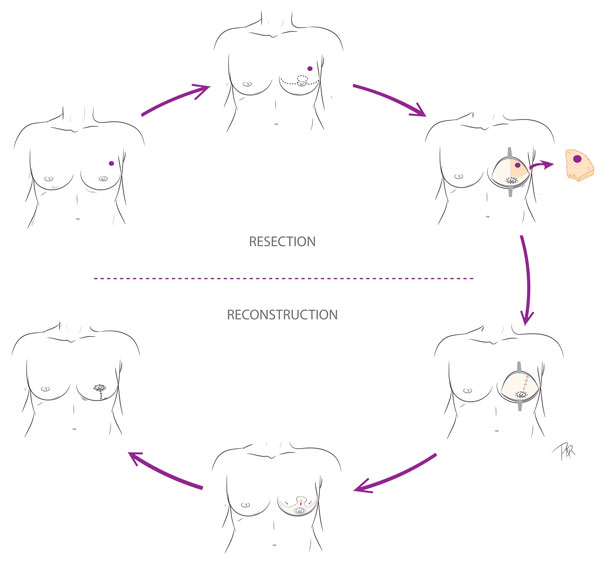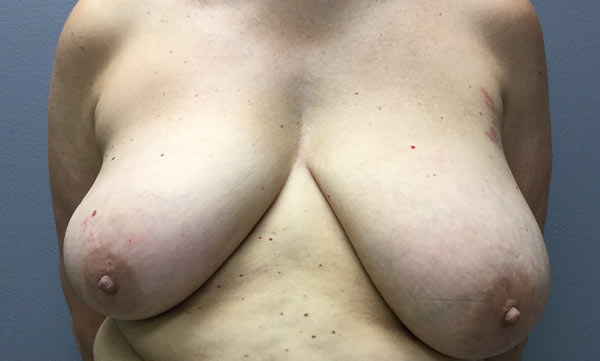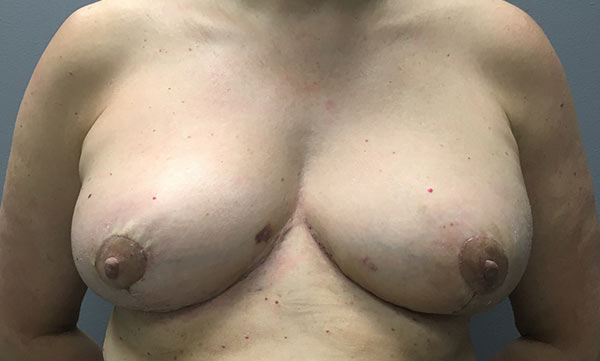Partial Breast Reconstruction
Women treated with a lumpectomy or partial mastectomy will often benefit from oncoplastic reconstruction, or breast reshaping at the time of the procedure, to minimize any distortion of the breast.

Many breast cancers can be treated with a lumpectomy, or removal of the tumor and a rim of normal breast tissue, followed by radiation therapy. This approach is termed “breast conservation therapy.” In general, this is a very safe alternative to a complete mastectomy, and the long-term outcomes are equally good.
The advantages of breast conservation therapy are less extensive surgery and preservation of the breast. Keeping the breast often achieves a better appearance and may be less impactful on a woman’s self-image when compared to mastectomy.
In some women, a lumpectomy can cause distortion or asymmetry between the breasts. An oncoplastic approach reshapes the remaining breast tissue at the time of the lumpectomy to avoid this complication and maintain a natural and attractive breast shape.

Who is a Candidate?
The decision between treating breast cancer with a lumpectomy or a mastectomy is made between the patient and her breast surgeon. Not every woman is a good candidate for breast conservation. When a breast cancer is very large or there are multiple areas of cancer, a lumpectomy may not be a good option.
Women who favor breast conservation (lumpectomy) but are felt to be at high risk for a poor cosmetic outcome may benefit from preoperative consultation with a plastic surgeon. This can include women with larger tumors, larger or ptotic (droopy) breasts, or women who require extensive skin resection with their lumpectomy. One of the best scenarios for an oncoplastic approach is a large breasted woman who might otherwise have considered a breast reduction. The procedure is undertaken much like a breast reduction but with the tumor strategically included in the breast tissue to be removed.

Benefits of Oncoplastic Reconstruction
- Minimizes distortion of the breast that can arise from lumpectomy
- Reshapes the breast to give a youthful and lifted appearance
- Can often better camouflage scars
- Allows oncologic surgeon to resect more tissue, often decreasing the need for re-excision
- Delivers a high rate of patient satisfaction
- Can usually be performed as an outpatient
Oncoplastic Breast Surgery: What to Expect
- The lumpectomy and breast reconstruction are performed during the same operation.
- A similar procedure is most often performed on the opposite breast to achieve good symmetry. This is also usually done during the same operation.
- Surgery takes approximately 3 or 4 hours, depending on the method of reconstruction.
- Most patients are discharged home the same day.
- A complete recovery can take 3 or 4 weeks.
- Radiation treatments usually begin 4 to 6 weeks after surgery.
During your consultation, share your goals and priorities with Dr. Davison and Dr. Pinell. This will help them identify the best method of reconstruction for you.


Left oncoplastic breast reduction and right breast reduction for symmetry.
Frequently Asked Questions
-
What are the risks of oncoplastic breast reconstruction?
Potential complications include bleeding, infection, problems of wound healing, unfavorable scarring, and asymmetry between the breasts. Nipple loss is uncommon but can occur. Changes in nipple sensibility are more common but typically recover on their own.
-
Do all women seeking breast conservation need reconstructive surgery?
No, most women do not experience significant distortion of the breast following lumpectomy. Ordinarily, the breast surgeon identifies women who may benefit from reconstruction and refers them to a plastic surgeon for preoperative consultation.
-
How long does an oncoplastic breast reconstruction take, and how long is a patient usually in the hospital?
Surgery can take 3 to 4 hours depending on the technique used. Patients are usually discharged home the same day.
-
What is the recovery time following an oncoplastic operation?
Patients should be out of bed the day of surgery. While most women have resumed a modified daily routine by 1 or 2 weeks, a full recovery can take up to a month.
-
If a woman develops a significant deformity after a lumpectomy, can anything be done?
Yes. There are many techniques to improve the shape of the treated breast or to achieve better symmetry between the breasts. However, the effects of radiation can pose a challenge to reshaping the breast. For that reason, oncoplastic reconstruction at the time of the lumpectomy usually produces the best results.
-
Do the surgeons at DAVinci Plastic Surgery perform oncoplastic breast reconstruction?
Yes! Dr. Davison and Dr. Pinell use a variety of oncoplastic techniques to reshape the breast at the time of lumpectomy.
-
Does insurance cover oncoplastic breast reconstruction?
Most insurance carriers cover oncoplastic breast surgery as well as symmetry operations on the opposite breast.
